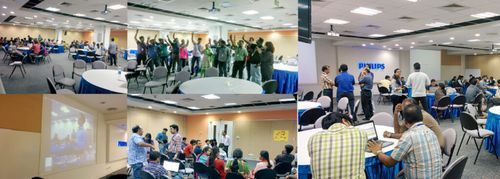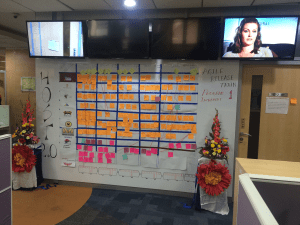
“Philips is continuously driving to develop high-quality software in a predictable, fast and Agile way. SAFe addresses this primary goal, as well as offering these further benefits: reduced time to market and improved quality, stronger alignment across geographically distributed multi-disciplinary teams, and collaboration across teams to deliver meaningful value to customers with reduced cycle time.”
—Sundaresan Jagadeesan, Program Manager – I2M Excellence SW Development Program
Challenge:
Philips sought to transition from traditional development to Agile, as well as bring an Agile mindset to business units beyond software to address the needs of a dynamic customer environment.
Industry:
Information Technology, Healthcare
Solution:
SAFe®
Results:
- Average release cycle time down from 18 months to 6 months
- Feature cycle time reduced from >240 to <100 days
- Sprint and PI deliveries on time, leading to “release on demand”
- Quality improvements—zero regressions in some business units
- 5 major releases per train per year on demand
Best Practices:
Philips recommends a straightforward, 4-step approach for any organization aiming to transition to Agile
- Develop products in the Agile way with focus on basic Agile practices (Scrum)
- Establish product ownership with a focus on enabling scaling aspects (SAFe practices)
- Establish a release pipeline with continuous integration (supported by automation)
- Adopt a DevOps culture with focus on continuous delivery (to production environment)
Introduction
Netherlands-based Royal Philips is a $26 billion medical technology company committed to making the world healthier and more sustainable through innovation. Their goal is to improve the lives of 3 billion people a year by 2025, so being able to achieve faster time to market has a direct impact not just on bottom line, but on millions of lives as well.

In 2014, the company began exploring the use of Agile methods to improve processes and increase efficiency across the organization. With a traditional, project-based approach to software development, release cycle time averaged 18 months. Philips had to accelerate delivery to meet market demands.
“Changing customer expectations and the tremendous pace of market disruptions require a framework and processes that are quick, scalable and responsive,” says Sundaresan Jagadeesan, Program Manager at Philips Electronic India Limited. “The Scaled Agile Framework® (SAFe®) with its non-linear approach and adaptability, is the way of the future.”
Vigorously Deploying SAFe
At Philips, the SAFe initiative fell within a program called I2M Excellence Idea to Market. The program is part of Accelerate!, a multi-year, worldwide business-transformation program designed to change the way the company does business and unlock its full potential. To that end, the company formed a foundational core of Scrum, upon which it could build SAFe practices.
“We chose SAFe to meet our goals of reducing time to market, improving quality, strengthening alignment across geographically distributed multi-disciplinary teams, and collaborating across teams to deliver meaningful value to customers with reduced cycle time,” says Jagadeesan.
Philips is now vigorously deploying SAFe in its software businesses and is piloting its use in complex systems environments (hardware, software, mechanical engineering, customer support and electrical teams). What’s more, the company has brought SAFe beyond software development to the R&D activities of a number of businesses, particularly in the Business Group, Healthcare Informatics, Solutions & Services (BG HISS).

Driving Feature Cycle Time Down 58%
To date, Philips has 42 ARTs running across various business units, making this one of the larger-scale SAFe implementations. With a focus on the systems business, the company has launched multiple ARTs there as well, including the first ART in Philips China.
The results:
- Average release cycle time down from 18 months to 6 months
- A greater focus on the customer mindset
- Feature cycle time reduced from >240 to <100 days
- Sprint and PI deliveries on time, leading to “release on demand”
- Quality improvements—zero regressions in some business units
- 5 major releases per train per year on demand, each catering to multiple products
- 3700+ people engaged in a SAFe way of working
- Around 1300+ trained and formally certified in Agile and SAFe
- Process and tooling alignment
The results from the original pilots caught the attention of and acted as catalyst for many other business units in Philips.

Offering Key Learnings
Through this process, transition leaders at Royal Philips learned what worked most effectively. They found it important to embed the Agile mindset and approach in other crucial areas of work—not just R&D, but in areas such as HR, Finance and Q&R—to ensure streamlined, efficient processes and quicker turnaround times.
Philips also found it critical to involve the senior management and leadership team of the organization in this SAFe transitional journey.
“Finally, to ensure an effective move to Agile, it is critical to change mindsets within the organization,” Jagadeesan says. “Agile implies continuous learning as enterprise behavior, decentralized decision-making, quick adaptiveness and more.”
“Any transformation program will be successful if you actively seek and solve business problems,” he adds.
Philips Royal recommends a number of organizational and cultural changes for any company making this transformation:
- Create an environment that encourages proactive, feedback-seeking behavior
- Motivate teams and give them the autonomy they need to function well
- Engage in courageous conversations
- Enable cultural change in the organization
- Focus on building teams for the long run with emphasis on stability
- Trust the team to solve problems by “teaching them to fish” instead of fishing for them
- Enable teams and support them by removing impediments
- Differentiate between outcome (value generated) and output (velocity-productivity improvements)
- Identify value streams and optimize around value to help the alignment and effective collaboration across the team
- Gain stakeholder alignment, and leadership commitment and support
- Train and coach based on roles
- Have a deployment strategy and change leaders’ coalition to help accelerate scaled Agile transformation
“Our Agile transformation journey is successfully underway,” says Jagadeesan. “It has been a tremendous learning experience, and we continue to deliver value to all our stakeholders and customers. Agile learning is an enriching and fun-filled journey!”

Share:
Back to: All Case Studies
Suggested Case Study:
Easterseals Northern California